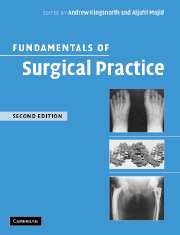Book contents
- Frontmatter
- Contents
- Preface
- Contributors
- 1 Preoperative management
- 2 Principles of anaesthesia
- 3 Postoperative management
- 4 Nutritional support
- 5 Surgical sepsis: prevention and therapy
- 6 Surgical techniques and technology
- 7 Trauma: general principles of management
- 8 Intensive care
- 9 Principles of cancer management
- 10 Ethics, legal aspects and assessment of effectiveness
- 11 Haemopoietic and lymphoreticular systems: anatomy, physiology and pathology
- 12 Upper gastrointestinal surgery
- 13 Lower gastrointestinal surgery
- 14 Hernia management
- 15 Vascular surgery
- 16 Endocrine surgery
- 17 The breast
- 18 Thoracic surgery
- 19 Genitourinary system
- 20 Head and neck
- 21 The central nervous system
- 22 Musculoskeletal system
- 23 Paediatric surgery
- Index
6 - Surgical techniques and technology
Published online by Cambridge University Press: 15 December 2009
- Frontmatter
- Contents
- Preface
- Contributors
- 1 Preoperative management
- 2 Principles of anaesthesia
- 3 Postoperative management
- 4 Nutritional support
- 5 Surgical sepsis: prevention and therapy
- 6 Surgical techniques and technology
- 7 Trauma: general principles of management
- 8 Intensive care
- 9 Principles of cancer management
- 10 Ethics, legal aspects and assessment of effectiveness
- 11 Haemopoietic and lymphoreticular systems: anatomy, physiology and pathology
- 12 Upper gastrointestinal surgery
- 13 Lower gastrointestinal surgery
- 14 Hernia management
- 15 Vascular surgery
- 16 Endocrine surgery
- 17 The breast
- 18 Thoracic surgery
- 19 Genitourinary system
- 20 Head and neck
- 21 The central nervous system
- 22 Musculoskeletal system
- 23 Paediatric surgery
- Index
Summary
SKIN PREPARATION
Traditionally patients were bathed the day before operation, the operative area was shaved and, especially before orthopaedic operations, the area was cleaned with antiseptic solution and then bound with sterile bandages. Many of these firmly held practices have been discarded. Hair removal should be avoided unless the hair will interfere with the operation. If it is to be removed, depilatory agents cause least damage. Shaving or clipping should be performed as close to the time of the procedure as possible, so that the abraded and scored skin cannot become contaminated with microorganisms.
Before starting the procedure, the skin of the operative site is cleaned with an antiseptic. Iodine in the form of povidone– iodine (10% in 10% alcohol) is popular; however, some patients are allergic to it and a test on a remote area of skin 24 h beforehand will exclude any resulting hyperaemia. Where there is a suspicion of hypersensitivity, chlorhexidine (0.5% or 0.5% in 10% alcohol) or 10% alcohol on its own can be used. Due to the danger of causing an explosion, it is essential that the alcohol is allowed to evaporate from all areas of skin before diathermy is used.
A sterile swab soaked in antiseptic solution is wiped along the line of the proposed incision, gradually extending the cleaned area centrifugally in ever-widening circles so that the incision line is not contaminated with a swab that has touched skin at the periphery.
- Type
- Chapter
- Information
- Fundamentals of Surgical Practice , pp. 71 - 88Publisher: Cambridge University PressPrint publication year: 2006



